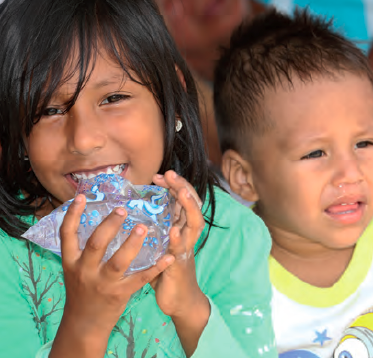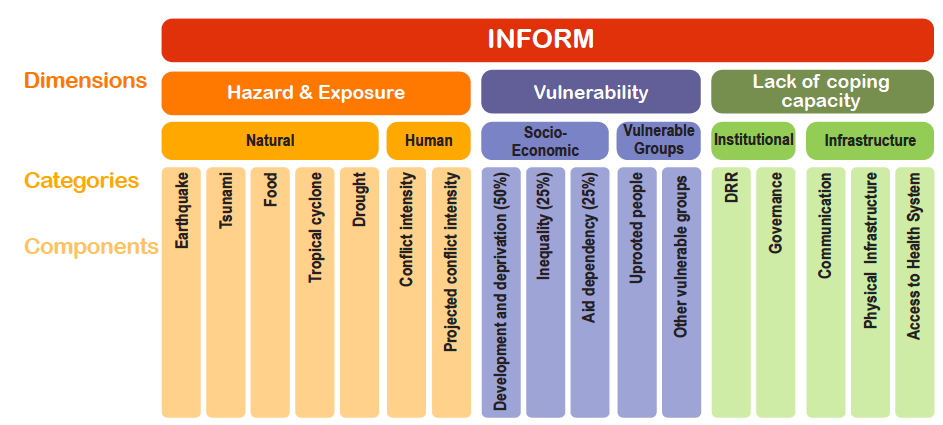Innovative regional approaches to improving Nutrition in Emergency (NiE) preparedness and response capacity from Latin America and the Caribbean (LAC)
 By Stefano Fedele, Regional Nutrition Specialist and Rebecca Olson, NiE Consultant at UNICEF LAC Regional Office
By Stefano Fedele, Regional Nutrition Specialist and Rebecca Olson, NiE Consultant at UNICEF LAC Regional Office
Nutrition hazards, risks, vulnerability and capacity in LAC
Improving preparedness and response capacity for NiE in Latin America and the Caribbean (LAC) is a challenging task. LAC has the highest urbanisation rate in the developing world, with 79% of the population living in cities. After Asia, it is also the region with the highest number of natural disasters, predominantly occurring during the hurricane season between May and November. Floods and storms are related to almost 70% of the disasters recorded. In absolute numbers, flood-related disasters have quadrupled in the past decade and storm-related disasters have increased five-fold. Drought-related disasters are also rising, with three and a half times as many in the past decade compared to the 1970s.
The risk of being affected by natural disasters is compounded by the level of the hazard and the degree of vulnerability. In the Caribbean region, with its diverse island states and annual tropical storms, there is a wide range of risk levels. In Haiti, low human development and severe environmental degradation cause far more damage compared to other Caribbean states, despite similar levels of exposure.
In recent decades, LAC has made significant strides in understanding and improving policies for disaster management, early warning systems and organisation of emergency response. If the 230,000 estimated deaths due to the Haiti earthquake and the recent Ecuador earthquake in which nearly 700 lost their lives are excluded, overall, fewer people die from natural hazards in the region today than a decade ago. Mexico, Chile, Colombia and Costa Rica are among the countries in the region that have improved their capabilities to predict some risks, as well as prepare for and manage emergencies. Moreover, although the capacity to ensure food assistance at times of emergency has increased, the prioritisation of nutrition as a programme area at times of disaster and the capacity to ensure adequate nutrition specific preparedness and response is not the same across the region.
Floods and droughts in LAC are expected to increase in frequency, intensity and unpredictability in the future. Providing safety nets and protecting communities present an increasingly difficult challenge for governments in the region. The least developed sub-national areas which are currently enduring higher rates of child stunting and inequity are also likely to be the most affected by climate change and consequent reduction in yields of subsistence crops, cash crops, soil and forest productivity and reduced livestock production. Infectious disease rates are also likely to increase due to the deterioration of water quality during droughts or floods.
While acute malnutrition (wasting) rates have steadily declined in LAC, and are generally below one per cent, the capacity to monitor any sudden increase and to promptly identify, refer and treat cases is still very limited in primary and secondary health facilities. Spikes that can occur in both emergency and non-emergency settings are often under-reported, increasing the risk of mortality and morbidity. In addition, exclusive breastfeeding rates are reducing in most LAC countries and, despite LAC’s high exposure to natural hazards, nutrition is too often seen by national authorities as primarily a health service supply issue or a problem that only needs food assistance to be addressed.
Regional and sub-regional NiE coordination: GRIN-LAC
Since 2013 UNICEF’s Regional Office for Latin America and the Caribbean (LACRO), based in Panama, has been supporting the development of a regional NiE group called GRIN-LAC (Grupo de Resiliencia Integrada de Nutrición), to strengthen NiE-related Disaster Risk Reduction (DRR), and emergency preparedness and response. With financial support from USAID OFDA, coordination is assured by LACRO, in close collaboration with other development partners. GRIN-LAC also works closely with the Global Nutrition Cluster (GNC) to improve the effectiveness of humanitarian response programmes by ensuring greater predictability, accountability and partnership.
GRIN-LAC has explored some innovative approaches to directly engage national NiE focal points. While most countries have people in charge of national nutrition programmes, many had not identified NiE as a priority area, or group emergency-related activities under civil protection or other mechanisms. A lot of effort went into mapping existing NiE focal points and, where these were missing, advocating for the need to appoint a specific person with adequate qualifications.
Since the region covers 36 countries, GRIN-LAC relies on three sub-regional support groups (Central America, South America and the Caribbean) to respond better to the specific needs of the different contexts. The three groups, including the national focal points, UN agencies, NGOs and other key NiE stakeholders, have quarterly webinars, an online document depository and a Facebook page for more rapid news-sharing.
In the past, regional NiE-related initiatives were very sporadic and involved a limited number of participants, while now representatives from 32 countries are regularly engaged and have initiated concrete improvements. These regional andsub-regional coordination and support mechanisms have been very well received and have strengthened partnerships across sectors, stakeholders and governments. They have also facilitated the exchange of information and the systematisation of best practices and lessons learned and ensured greater effectiveness, predictability and accountability of NiE preparedness and response in LAC.
The GRIN-LAC Matrix
A major challenge in the development of the GRIN-LAC approach has been the lack of a standardised definition of what NiE preparedness and response should be in LAC. To address this, LACRO has proposed a tool (GRIN-LAC Matrix) for the development of a standardised definition across countries in LAC of minimum NiE preparedness and response capacity to be used as a baseline, allowing for the prioritisation of countries for support and monitoring progress over time.
The Matrix goes beyond simple hazard and risk analysis to examine specific nutrition-related vulnerabilities and capacities at the country level. It is intended to:
- Generate a model for defining minimum preparedness and response capacity for NiE at the national and regional level in a standardised way, and monitor progress over time;
- Develop a common understanding of preparedness and response capacity (for resource mobilisation, planning and promotion);
- Improve the quality of regional and country-level nutrition data; and
- Identify gaps and facilitate convergence of efforts to increase resilience.
The GRIN-LAC matrix covers 32 countries in the LAC region and works at the national level by combining the values and indicators already included in the three dimensions of the INFORM model1 (Hazards Exposure, Vulnerability and Lack of Coping Capacity) with 12 nutrition-specific indicators. The additional indicators constitute 40% of the model and are grouped under the vulnerability and capacity categories. The additional nutrition indicators included in the GRIN-LAC matrix are intended to complement the one currently measured through the INFORM model, as well as add an additional level of analysis relevant to NiE. This is not an exhaustive list but a minimum set intended to capture some key aspects influencing country preparedness and response capacity.
The GRIN-LAC Matrix allows us to achieve a consensual starting point for the convergence of efforts and the monitoring of progress over time. The Matrix has been widely welcomed by regional and national counterparts and other partners and the model is also being adapted by other sectors in LACRO (e.g. WASH and education).
GRIN-LAC web page hosted by OCHA-REDHUM, main document repository, including capacity building materials; GRIN-LAC’s Facebook page.

References
1 INFORM is a collaboration of the Inter-Agency Standing Committee Task Team for Preparedness and Resilience and the European Commission; more information can be found here

